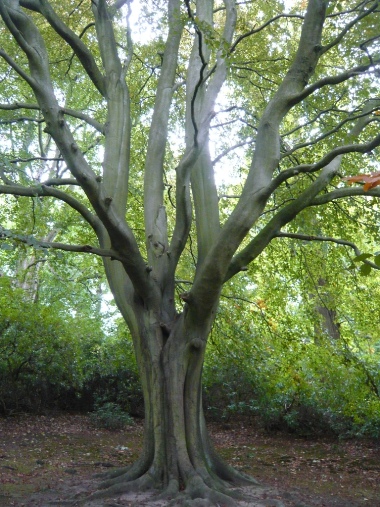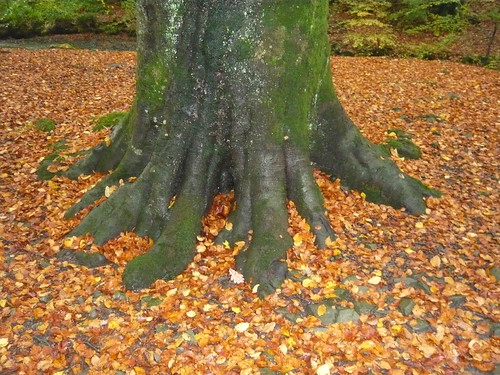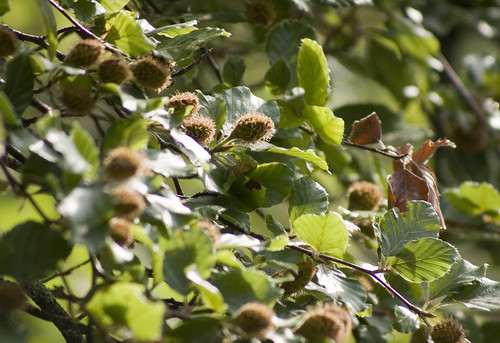
Beech Tree – Root and Branch Review
I used to think Beech trees grew on the beach but now I know a little better but not much. This is one of the UK’s most useful trees and deserves to be grown where ever space permits.
Key Features of the Beech
- Latin name Fagus sylvatica other common names include ‘Lady of the Woods’ or European Beech
- Height up to 45m 150 feet trunk can be 10 feet in diametre
- Type of tree Deciduous, broadleaved, dictoyledon tree
- Leaves – Light green turning deeper in summer are ovate shaped with wavy edges. Decorative in autumn with copper and russet foliage.
- Flowers Male are in yellow pendulous clusters whilst female flowers are inconspicuous in leaf axils on the same tree.
- Fruit Beech nuts are 3 sided brown nuts contained in pairs or singly inside prickly green/brown husks
- Bark is silver gray thin and smooth
- Family Fagus
Origins and Distribution of the Beech
- Grows widely throughout Europe and likes chalky and limestone areas.
- Native to England it may have been introduced by stone age man for the food property of the nuts.
Uses and Commercial Attributes of the Beech
- Beech nuts or ‘mast’ are still used to feed pigs and parkland deer.
- Wood from the beech is tough and used for flooring and furniture.
- Wooden implements like bowls, spoons and tool handles are traditionally made from beech
- Beech woodlands often act as home for mushrooms.
- Beech hedges are popular as the young plants are easy to train and retain their leaves through winter
- Beech fruit are edible and have a nutty flavour but should not be consumed in great quantity as they can be toxic.
- Beeches can live for 300 years and are used as wind breaks and field markers as well as part of mixed hedges particularly when young.
- Wood from the beech is used as a fuel.
Gardeners Tips for the Beech
- Leaves remain on the tree until the spring making beech popular as a hedge.
- Wood is easy to turn and work for carpentry particularly if soaked first to make it pliable.
- Limited topiary is possible with a beech tree.
- Older trees have buttresses to improve stability.
- Read Copper Beech Hedges
Other types of Beech and Species
- Copper Beech or Purple Beech Fagus sylvatica Purpurea atropunicea has purple leaves some turning deep green by mid-summer.
- Weeping Beech or Fagus sylvatica Pendula has branches that hang down as the name suggests
- Fagus sylvatica ‘Rivers Purple’ also known as ‘Riversii Major’ has been awarded an Award of Garden Merit
- A narrow cultivar of beech Fagus sylvatica ‘Dawyck’ develops into a striking cone shape.
Beech Comments from Elsewhere
- ‘A coppard is an ancient tree that was coppiced hundreds of years ago and then later pollarded. This prolongs their life and this beech tree could be anything up to 1,000 years old and was first cut by Anglo-Saxon woodmen’ Jacks Hill Epping

Credits
Beech Trees by Joost J. Bakker IJmuiden CC BY 2.0
Lake Wood, Uckfield – Beech Nuts by Dominic CC BY 2.0 below
Part of a Slideshow / Set forming a virtual tour around the lake at Lake Wood, on the outskirts of Uckfield, East Sussex, England, UK. [Map]
The artificially expanded lake and woodland is adjacent to, and to the north of, West Park Local Nature Reserve. The two areas are separated by Rocks Road (the B2012 Uckfield / Piltdown road). Both areas formed part of the Rocks Estate, owned for 200 years – and landscaped in the style of Capability Brown – by the Streatfield family. A tunnel beneath the dividing road (now bricked off) enabled carriage access to the lake from Rock House.
The area has numerous Ardlingly Sandstone outcrops. Where these obstruct the path around the lake, a tunnel – and also steps leading down to an underground boat house cave – were excavated.
Lake Wood is managed and protected by The Woodland Trust
Read about our series on British tree reviews with a bakers dozen fact sheets




3 thoughts on “Beech Tree – Root and Branch Review”
Comments are closed.